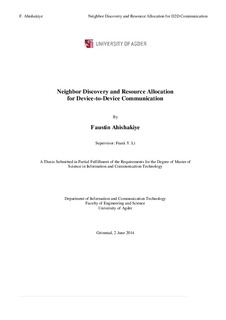| dc.contributor.author | Ahishakiye, Faustin | |
| dc.date.accessioned | 2014-09-24T08:56:10Z | |
| dc.date.available | 2014-09-24T08:56:10Z | |
| dc.date.issued | 2014 | |
| dc.identifier.uri | http://hdl.handle.net/11250/221400 | |
| dc.description | Masteroppgave i Informasjons- og kommunikasjonsteknologi IKT590 Universitetet i Agder 2014 | nb_NO |
| dc.description.abstract | Device-to-Device (D2D) communication has attracted lots of attention as one of the most advanced wirelesscommunication technologies which allows access to services offered by nearby devices bypassing the BaseStation (BS). The potential advantages of this direct communication paradigm include high data rate, networkoffloading and range extension, as well as commercial proximity services and social networking. From the UserEquipments (UEs) and BS perspective, additional protocol overhead and discovery resource are required forD2D links. In such a context, neighbor discovery and resource allocation approaches need to be studied. For anefficient D2D communication, the main problem is how the UEs in proximity detect each other and establish aD2D link in a timely and efficient manner. In this thesis we investigate D2D-enabled cellular network and westudy neighbor discovery and resource allocation in such network. We split the cell into two parts: the inner partin which UEs communicate via BS and the outer part where UEs use D2D links as a means of communication.The blocking probability for these two parts is calculated based on Poisson and Engset distributions. Wepropose two protocols for neighbor discovery, namely, reactive (on-demand) discovery and proactive (multicast)discovery and both of them are infrastructure-coordinated protocols. The control overhead is calculated andnumerical results are provided based on three cases of D2D pair requests in different timeslots in order tocompare these two protocols. The performance evaluation and results show that the reactive protocolperforms better when the D2D communication traffic load is low whereas proactive protocol is preferable ifD2D communication demand is high. If the overflowed UEs in proximity are allowed to discover each otherusing our protocols together with dedicated resource from the BS and communicate via D2D links; results showthat the cellular network blocking probability is reduced.Keywords: Device-to-Device communication, ProSe discovery, protocol design, control overhead, performancecomparison. | nb_NO |
| dc.language.iso | eng | nb_NO |
| dc.publisher | Universitetet i Agder ; University of Agder | nb_NO |
| dc.subject | IKT590 | nb_NO |
| dc.subject | Device-to-Device communication ; ProSe discovery ; protocol design ; control overhead ; performance comparison | nb_NO |
| dc.title | Neighbor discovery and resource allocation for device-to-device communication | nb_NO |
| dc.type | Master thesis | nb_NO |
| dc.subject.nsi | VDP::Technology: 500::Information and communication technology: 550 | nb_NO |
| dc.source.volume | IX, 68, [5] p. | nb_NO |
